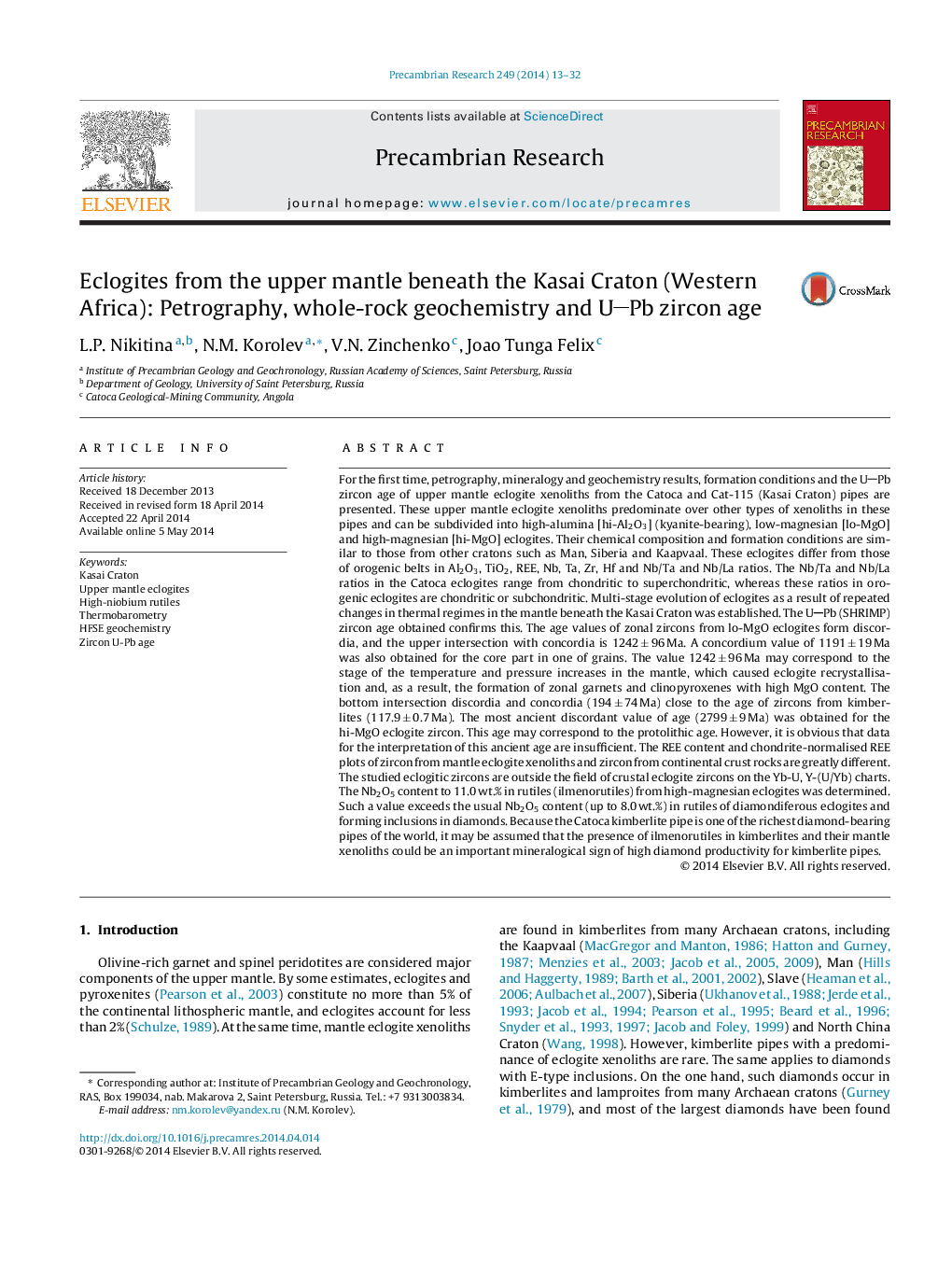| کد مقاله | کد نشریه | سال انتشار | مقاله انگلیسی | نسخه تمام متن |
|---|---|---|---|---|
| 4722993 | 1639625 | 2014 | 20 صفحه PDF | دانلود رایگان |

• P–T and petrochemical profiles (100–170 km dept range) for Kasai Craton.
• The mineralogy of xenoliths suggesting two stages in thermal regime at least.
• Aspects of Nb and Ta fractionation in the upper mantle.
• The first age data for mantle eclogites from the Catoca pipe.
• Rutiles from hi-MgO eclogites containing up to 11 wt.% Nb2O5 (ilmenorutiles)
For the first time, petrography, mineralogy and geochemistry results, formation conditions and the UPb zircon age of upper mantle eclogite xenoliths from the Catoca and Cat-115 (Kasai Craton) pipes are presented. These upper mantle eclogite xenoliths predominate over other types of xenoliths in these pipes and can be subdivided into high-alumina [hi-Al2O3] (kyanite-bearing), low-magnesian [lo-MgO] and high-magnesian [hi-MgO] eclogites. Their chemical composition and formation conditions are similar to those from other cratons such as Man, Siberia and Kaapvaal. These eclogites differ from those of orogenic belts in Al2O3, TiO2, REE, Nb, Ta, Zr, Hf and Nb/Ta and Nb/La ratios. The Nb/Ta and Nb/La ratios in the Catoca eclogites range from chondritic to superchondritic, whereas these ratios in orogenic eclogites are chondritic or subchondritic. Multi-stage evolution of eclogites as a result of repeated changes in thermal regimes in the mantle beneath the Kasai Craton was established. The UPb (SHRIMP) zircon age obtained confirms this. The age values of zonal zircons from lo-MgO eclogites form discordia, and the upper intersection with concordia is 1242 ± 96 Ma. A concordium value of 1191 ± 19 Ma was also obtained for the core part in one of grains. The value 1242 ± 96 Ma may correspond to the stage of the temperature and pressure increases in the mantle, which caused eclogite recrystallisation and, as a result, the formation of zonal garnets and clinopyroxenes with high MgO content. The bottom intersection discordia and concordia (194 ± 74 Ma) close to the age of zircons from kimberlites (117.9 ± 0.7 Ma). The most ancient discordant value of age (2799 ± 9 Ma) was obtained for the hi-MgO eclogite zircon. This age may correspond to the protolithic age. However, it is obvious that data for the interpretation of this ancient age are insufficient. The REE content and chondrite-normalised REE plots of zircon from mantle eclogite xenoliths and zircon from continental crust rocks are greatly different. The studied eclogitic zircons are outside the field of crustal eclogite zircons on the Yb-U, Y-(U/Yb) charts. The Nb2O5 content to 11.0 wt.% in rutiles (ilmenorutiles) from high-magnesian eclogites was determined. Such a value exceeds the usual Nb2O5 content (up to 8.0 wt.%) in rutiles of diamondiferous eclogites and forming inclusions in diamonds. Because the Catoca kimberlite pipe is one of the richest diamond-bearing pipes of the world, it may be assumed that the presence of ilmenorutiles in kimberlites and their mantle xenoliths could be an important mineralogical sign of high diamond productivity for kimberlite pipes.
Journal: Precambrian Research - Volume 249, August 2014, Pages 13–32